Features of operation of a pneumatic wrench
Any master knows that the most time-consuming process when assembling structures or repairing mechanisms is to unscrew and tighten the threaded connections. But if pneumatic wrenches are used for these purposes, then such work turns into an ordinary formality. This handy tool has many advantages, but you should learn more about the nuances of its operation.
Content
The device and the principle of operation of the pneumatic wrench
In the figure below you can see in detail the device pneumatic wrench. The unit consists of the following elements placed in a durable metal case.
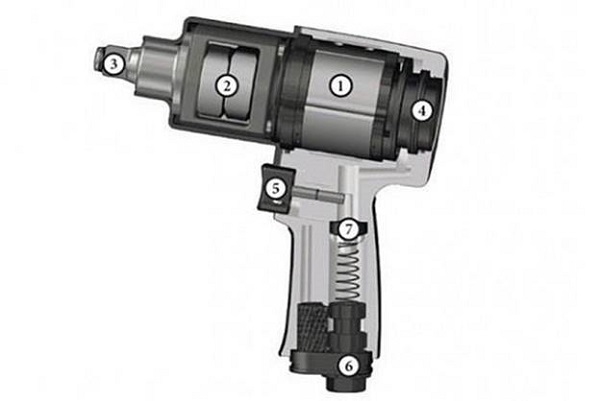
- High performance air motor.
- Impact mechanism.
- Alloy steel cartridge (stop).
- Torque regulator, and reverse.
- Start button.
- The union, for connection of a hose from the compressor.
- Air valve.
This unit due to the lack of a motor is much lighter than its electrical counterpart. And the torque wrench has high rates - from 300 to 2200 Nm (Newtons per meter).
Inside the unit can be identified 2 main power units, each of which is designed to work in different modes. The first block is an air motor that transmits rotational motion to the tool head. The second block is the node that creates the shock loads. The pneumatic actuator rotates due to the passage through it of compressed air supplied through a high pressure hose from the compressor.
In the case of the device there are 2 channels. For each of them, the air is directed in different directions relative to the turbine. In the first case, the air pushes the turbine in the direction of the arrow, that is, in the tightening, and in the second - against the arrow in the direction, in the unscrewing of the fastener. Distributed air flow special switch.
Principle of operation pneumatic wrench is as follows.
- After pressing the start button, the valve opens, and the air flow from the hose connected to the device’s body begins to move through the turbine, rotating it.
- From the turbine rotational motion is transmitted to the impact mechanism, which in its principle of operation resembles a clutch. The mechanism includes 2 cams of complex configuration. The impact force is formed by the cams at the moment when the release of the fastener does not have enough torque.
- Further, the rotational movement is transmitted to the stop (cartridge), on which the nozzle is put under a certain size of the nut. As a result, tightening or loosening fasteners. Some air wrenches do not use a percussion mechanism when tightening, the process takes place in the unstressed mode.
- If the nut is stuck, then it will take more effort to unscrew it, and at this point the rotation of the stop stops.
- The hammers begin to tilt back, simultaneously turning.
- In the next stage, the cams bypass the engagement with the stop and, continuing the movement, gain inertia.
- Continuing to turn, the cams again engage with the stop and strike at it (in the direction of motion).
- Impact pulses continue until the fastener is “broken” from the spot.
Thus, using a pneumatic impact tool, the process of unscrewing taut bolts and nuts is easy and fast.
The choice of compressor for pnevmogaykovert
Many motorists, buying a pneumatic wrench, wonder what kind of compressor is needed for this unit. First of all, you should pay attention to its performance on the passport. Here there is one caveat: some companies that produce compressors, in order to increase sales, indicate the productivity not at the output, but at the input. For example, in the documentation for the unit indicated its performance of 210 liters per minute. So, this indicator should be interpreted as the rate of air injection by the compressor into itself, that is, into the receiver. At the output, the productivity can fall by approximately 30-40%. And it turns out that the unit actually produces only 146-127 l / min.
Based on the foregoing, it can be understood that if the compressor has a capacity of 210 l / min, then you need to choose a wrench with significantly lower air jet speeds.For example, if the working air flow rate at the instrument is 200 l / min, and the compressor according to the documentation is 210 l / min (really - 146-127 l / min), then you will not be able to unscrew it or screw it up qualitatively with such a tool.
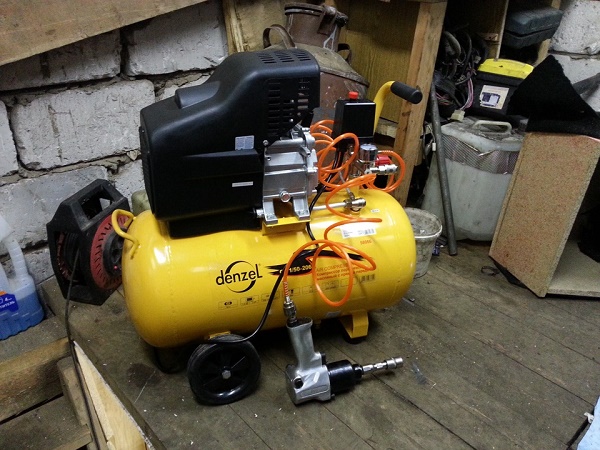
Besides, receiver volume also plays an important role. In household units, the cylinder may have a volume of only 24-50 liters. Under these conditions, the wrench will not work normally. Even with a receiver volume of 50 liters, after a few seconds of tool operation, the pressure in it is significantly reduced, and to continue work you have to wait until it recovers. Therefore, the compressor receiver should have a volume of more than 50 liters, and the unit itself should create a pressure in it not lower than 6.2 kg / cm². Otherwise, the device will not be able to develop the necessary power.
But one should not allow too high pressure in the system. Exceeding the recommended indicator of pressure adversely affects the main components of the tool, leads them to rapid wear and, as a result, the wrench failure.
The result of the above is as follows: if the tool is designed for a working air speed of 119 l / min and the compressor for the wrench gives out 135 l / min in reality, then it can be used to unscrew and tighten the fasteners on the wheels without any problems.But do not forget that the tool must have a torque not lower than 550 Nm.
Hose selection
You should be aware that the hose that comes with the compressor, especially from China, is not suitable for the effective operation of the wrench. Most often, these hoses have an internal cross section of about 6 mm. Such a capacity of the hose will not be enough to supply the required amount of air to the pneumatic tool. They, perhaps, you can blow off the dust, apply to the spray gun, but no more. Even pumping tires with it takes a lot of time.
Therefore, it is necessary to get another hose with a higher capacity. Ideally, it could be gas hosewhich is purchased in the gas equipment store. It will be visible markings (Propane-Butane), as well as the maximum pressure that it can withstand, the value of the internal diameter.
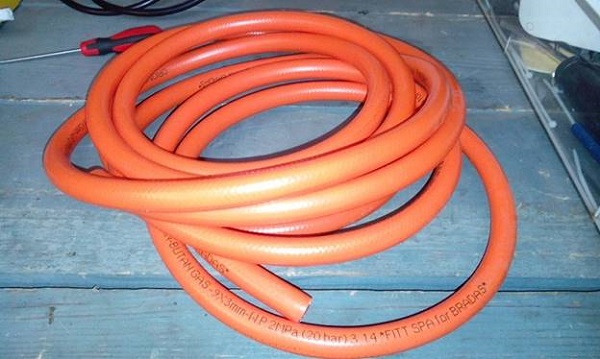
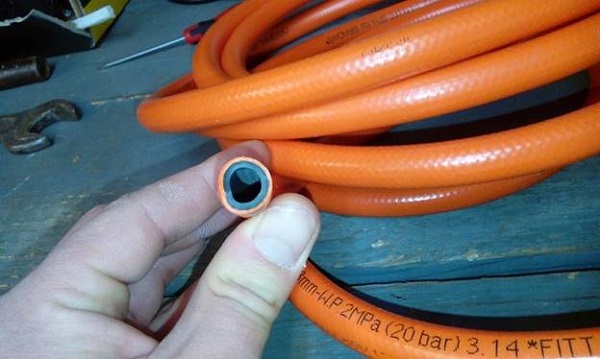
Why does the compressor need a filter?
The air leaving the compressor must be clean, that is, without various impurities that can damage the wrench. Not everyone knows that in the inner space of the receiver during air compression condensate falls out. Also, the oil can get into the receiver along with the injected air if the mechanical part of the unit is severely worn out. Oil, mixing with condensate (moisture), takes the form of an emulsion and enters the instrument through a hose connected to it. This emulsion can cause corrosion of all parts mechanical part of the unit. For this reason, wrenches filled with water and rust, with broken knots, often get into the service workshops.
In order not to bring the instrument to such a deplorable state, it is decided to install the compressor filter dehumidifier. Inside it is a mesh filter, made by a special technology of bronze.

The air passing through the filter gives up moisture and loses all impurities that enter the sump. Typically, the body of the dehumidifier is made of a transparent material to track the amount of dirt accumulated during operation.
The sump also has a valve (located at the bottom) through which all contaminants are easily removed.
The fact that the filter is dirty and does not provide the desired air flow rate can be determined by the drop in power of the tool. The wrench in the first seconds begins to work within the normal range, but then suddenly slows down and loses power. This fact is explained by the fact that the launch of the tool is due to the accumulated air in the hose, after which it becomes insufficient due to the low throughput of the clogged filter. In such cases, the filter is removed, washed in solvent, and then well blown by air. In extreme cases, the filter has to be changed. It can be purchased at shops selling pneumatic tools.
The choice of oil for the wrench
The lubrication of this pneumatic tool should be treated with particular seriousness. If the unit can work without purified air for some time, then without lubrication it will fail very quickly. Oil entering the moving parts of the apparatus reduces friction between them, and also removes wear products in the form of fine dust. This dust is able to fill the gaps between the blades and the rotor, which inhibits their movement. As a result, the power of the tool is significantly reduced. Problem is solved installation in the lubricator system. The photo below shows its linear type.
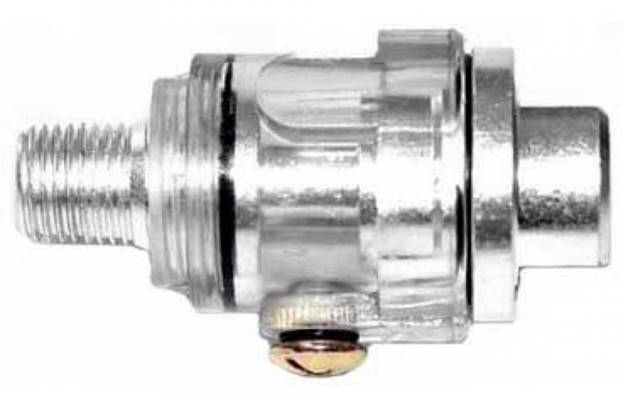
But the installation of the “oil can” will help to prolong the service life of the wrench only if you pour into it a special lubricant intended only for pneumatic tools that have the necessary viscosity.
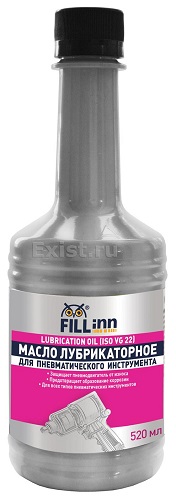
Try to get the oil for the wrench, which recommends tool manufacturer. In the extreme case, you should use only the oil of a synthetic type, which has good antiwear and anti-corrosion properties and does not contain silicone.
It is impossible to pour transmission oil or engine oil into the lubricator, since it has a viscosity higher than that required and successfully “sticks” the blades of the pneumatic actuator, because of which the unit loses power.
Special lubricant can also be purchased at companies that offer pneumatic tools.
Lubrication rules
If for any reason you do not have the opportunity to install a lubricator on your unit, then, you can get out of the situation in the following way.
- Immediately before starting the wrench, it is necessary to unscrew the hose from it and put 3 to 5 drops of grease into the tool fitting.
- Next, return the hose to its original place and switch on the unit briefly (thirty seconds will be enough).Thanks to this operation, an even distribution of oil will occur across all moving units of the device.
Lubrication in this way must also be carried out before long-term storage of the instrument. When using the unit in intensive mode, the oil should be instilled into the nozzle every 3-4 hours.
Although this method helps to extend the life of the wrench, it is very inconvenient. We have to interrupt work and spend time cleaning the tool from dirt in the area of the nozzle, on the preparation of lubrication. Also during the procedure, you should carefully ensure that the unit no dust hit. For these reasons, it is recommended to install a lubricator in the system, which will always deliver lubricant to the tool in a timely manner.
Air Wrench Tips
To extend the life of a pneumatic tool, it is recommended to listen to some tips from professional craftsmen.
- Do not drop the tool.
- It is necessary to ensure that the pneumatic tool is located outside the area where a car can run into it.
- To increase puff power, do not over-pressure the system.This leads to rapid wear of the unit.
- The wrench should not be kept under load for a long time, since such a mode of operation will quickly disable the impact mechanism. If the “stuck” nut or bolt does not turn away within 5 seconds, then the unit should be stopped and replaced with a more powerful one. Also recommended for problem bolts. penetrating fluidsthat are in the arsenal of any car owner: gasoline, antifreeze, kerosene, diesel fuel, brake fluid. It is best to apply a special liquid to the threaded joint, for example, WD-40.
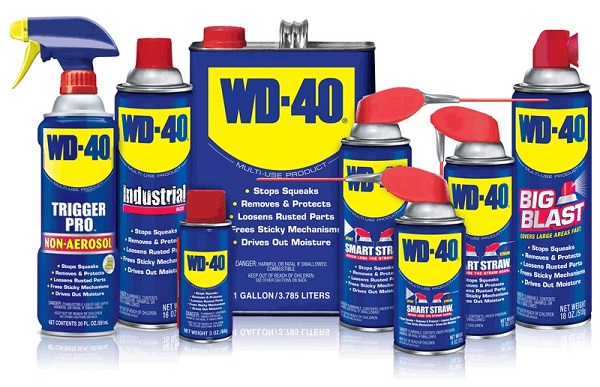
- Do not store the instrument near fire, as well as in places with high temperature and humidity.
If you follow these simple recommendations, then your tool will become an effective assistant in performing labor-intensive operations, will serve for a long time and will justify the investment in it.

/rating_off.png)











